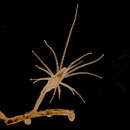Cordylophora caspia
provided by wikipedia EN
Cordylophora caspia (or freshwater hydroid) is a species of athecate hydroid in the family Cordylophoridae.[1]
Distribution
C. caspia is native to brackish and fresh water habitats around the Black Sea and Caspian Sea. From there it has spread, on the hulls of ships or by some other means, via channels and inland waterways to most of the temperate and tropical world.[1] It arrived in the Baltic Sea in the early nineteenth century and spread rapidly to the estuaries and inland waterways of Western Europe, reaching Ireland by 1842. By 1885 it had made its way to Australia and by 1944 to Panama. It has not reached Antarctica.[2]
References

- license
- cc-by-sa-3.0
- copyright
- Wikipedia authors and editors
Cordylophora caspia: Brief Summary
provided by wikipedia EN
Cordylophora caspia (or freshwater hydroid) is a species of athecate hydroid in the family Cordylophoridae.
- license
- cc-by-sa-3.0
- copyright
- Wikipedia authors and editors
Alien species
provided by World Register of Marine Species
The freshwater hydroid Cordylophora caspia occurs in both fresh and brackish water. The hydroid naturally occurs around the Caspian and Black Sea. By attaching itself to ship hulls and/or floating material (e.g. plant debris) this polyp has spread to the brackish waters of Western Europe through rivers and channels. The first European report was along the Swedish coast in 1814. This coelenterate was observed in Belgium for the first time in 1905, in Nieuwpoort.
VLIZ Alien Species Consortium. (2010).
- license
- cc-by-4.0
- copyright
- WoRMS Editorial Board
Alien species
provided by World Register of Marine Species
De brakwaterpoliep Cordylophora caspia is een organisme van het zoete én het brakke water. Het oorspronkelijke areaal van de brakwaterpoliep ligt rond de Kaspische Zee en de Zwarte Zee. Door zich vast te hechten aan scheepsrompen en/of aan drijvend materiaal (vb. plantenresten) heeft deze poliep via rivieren en kanalen de brakke wateren van West-Europa bereikt. De eerste Europese waarneming gebeurde langs de Zweedse kust in 1814. Dit neteldier werd voor de eerste keer waargenomen in België in 1905, in Nieuwpoort.
- license
- cc-by-4.0
- copyright
- WoRMS Editorial Board
Biology
provided by World Register of Marine Species
colonial
van der Land, J. (ed). (2008). UNESCO-IOC Register of Marine Organisms (URMO).
- license
- cc-by-4.0
- copyright
- WoRMS Editorial Board
Distribution
provided by World Register of Marine Species
Prince Edward Island (from the northern tip of Miscou Island, N.B. to Cape Breton Island south of Cheticamp, including the Northumberland Strait and Georges Bay to the Canso Strait causeway), southern Gaspe waters (Baie des Chaleurs, Gaspe Bay to American, Orphan and Bradelle banks; eastern boundary: Eastern Bradelle Valley), Middle North shore (from Sept- Iles to Cape Whittle, including the Mingan Islands), Western slope of Newfoundland , including the southern part of the Strait of Belle Isle but excluding the upper 50 m in the area southwest of Newfoundland
North-West Atlantic Ocean species (NWARMS)
- license
- cc-by-4.0
- copyright
- WoRMS Editorial Board
Habitat
provided by World Register of Marine Species
infralittoral of the Gulf and estuary
North-West Atlantic Ocean species (NWARMS)
- license
- cc-by-4.0
- copyright
- WoRMS Editorial Board
Habitat
provided by World Register of Marine Species
Temperature 16°C, 11.5 PSU (brackish).
Bolnick, D. (2007) A Guide to the Common Wild Flowers of Zambia and Neighbouring Regions Revised Edition. WECS, Lusaka, Zambia
- license
- cc-by-4.0
- copyright
- WoRMS Editorial Board

